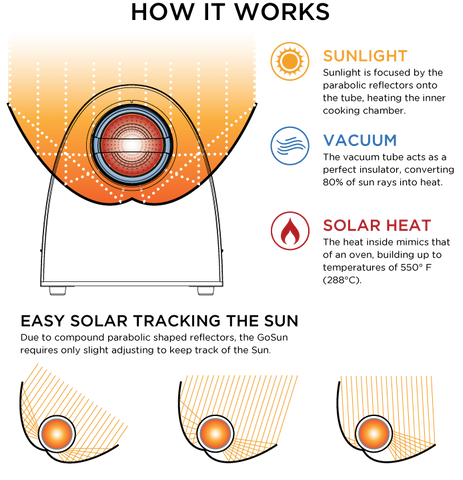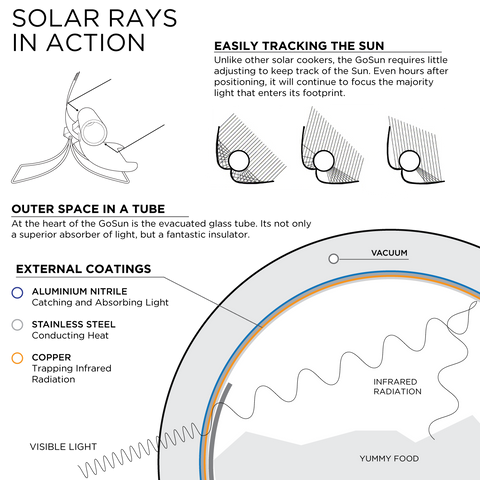How do solar cookers work?
One of our ultimate goals is to demonstrate and train how solar cooking technology works and how this type of technology can better the lives of families everywhere. Understanding the various physical science principles that makes GoSun cook helps new solar chefs understand what it takes to harness the power of the sun, and create some serious cooking power to create some.
Reflection & Ray Tracing
To generate functional cooking temperatures from the sun, you are going to need to gather or concentrate a lot of sun. Using mirrors and other reflective surfaces, we can move the sun’s rays around and increase their intensity onto a specific surface. By using aluminum foil, Mylar, or mirrors, solar ovens basically multiply the amount of sun on a cooking chamber to boost its efficiency.

Ray Tracing is a “method of calculating the path of waves or particles through a system of regions by varying propagation velocity, absorption characteristics, and reflecting surfaces.” Many conditions and surfaces complicate the analysis because waves and rays tend to bend, refract, and reflect off surfaces. Good, everyday examples of the complexity of ray tracing are radio, tv and cell phone waves, each with different parameters and affecting the way our receivers capture those waves for our use, which becomes very apparent when mountains interfere with them.
There are many ways to manipulate solar rays before directing them to strike an absorbing surface that can be heated. We carefully crafted the GoSun’s reflectors to direct sunlight coming in from various angles to be centered onto the tube. Examine your GoSun’s reflectors and see if you can make out any images; your eye’s rays should see your tube reflected just as the sunlight’s rays.
The Greenhouse Effect: Absorption & Insulation
It’s not easy to accumulate enough heat to cook with the sun so after the solar harnessing via the reflectors you’re going to need to hold onto as much of that concentrated sunlight as possible. In order to do this, the Greenhouse Effect is critical to any solar cooker. It is also a critical process by which our planet is made habitable. The Greenhouse Effect is "the process by which radiation from a planet's atmosphere (heated by the sun) warms the planet's surface to a temperature above what it would be without its atmosphere" according to Wikipedia. A Greenhouse works in a similar fashion as does the GoSun Stove, by letting light in through glass and preventing its escape, heating the interior. Climate Change is caused by an aberration of this process. CO2 is a critical gas in our atmosphere, which captures the suns heat and enhances the Planet's Greenhouse Effect, making our Planetary home habitable. Unfortunately, due to fossilized CO2 being released through the burning of fossil fuel (refer to our blog post "Peril or Promise" to learn more about this) we are enhancing this process to a currently unknown end. Fortunately, by you cooking on your GoSun you are not only mitigating this process but also utilizing this science to create tasty food.... definitely a win win for you and our planet. Once the sun passes through the tubes first layer of glass it needs an effective way to capture and hold that heat, which absorbing colors and materials make that possible. The proprietary, nontoxic dark metal coating on the inside tube of your GoSun is designed to soak in as much of that concentrated sun as possible. We'll come back to this process later as we explore the actual cooking process

This Greenhouse Lets Light In, But Won’t Allow Heat To Escape
By Joi Ito [CC BY 2.0 (http://creativecommons.org/licenses/by/2.0)], via Wikimedia Commons
After this we need to prevent it from escaping, of which insulation is one of the best methods in which to do this. Whether it's fiberglass insulation, rigid foam insulation or cellulose, they all prevent energy escaping by sealing pockets of air. Glass, unfortunately, is not a good insulator and the problem with most solar ovens is that the heat rises out the top where a single layer of glass does little to hold the heat inside. Fortunately, in the 20th century, vacuum technology became an important development with incandescent light bulbs and vacuum tubes for various technical applications, such as TV’s and radios. Outer space is an even higher quality vacuum, producing conditions that have raised awareness about the impact of vacuum properties. The GoSun Stove utilizes this science with the evacuated tube, which is essentially a vacuum sealed between two layers of extremely durable glass. This vacuum allows the tube to act as a tremendous insulator, preventing that concentrated sunlight from escaping, keeping your food or liquids hot, just like a Thermos, even in cold conditions.
Thermodynamics & Cooking
According to NASA, thermodynamics is “the study of the effects of work, heat, and energy on a system.” These principles are fundamental to successful solar cooking.

Earth's Energy Budget via NASA
Radiation
The primary and most powerful aspect of the sun for cooking is via radiation. The GoSun utilizes this solar powered radiant fuel by capturing those waves of energy from the trusty old sun in the form of infrared radiation, which is the main aspect of sunlight that powers the GoSun. Bright sunlight provides an irradiance of just over 1 kilowatt per square meter at sea level. Of this energy, 53% is infrared radiation, 44% is visible light, and 3% is ultraviolet radiation.
The evacuated tube’s specific coatings are designed to harness this solar energy form as efficiently as possible. The efficiency of the GoSun Stove is currently being tested, but is estimated to peak out around 80%. That means 80% of the infrared, visible light and ultraviolet radiation from the Sun is turned into heat inside the tube’s chamber.

Conduction
Another type of heat transfer is when objects are in direct contact with each other. When an object is heated, the particles move faster and bump into nearby particles and ultimately transferring the energy to the particles of a object that make contact. This happens inside your GoSun Stove’s cooking chamber when sunlight heats up the collector tube which transfers into the cooler cooking tray and food, changing the internal energy of all of elements involved. Different types of materials conduct heat better than others, for example metal is better than wood; we chose to use stainless steel for this reason (along with its durability).
Convection
This happens in liquid or gas which causes transfers of heat from the hotter areas to the cooler areas. When warm air or liquid rises, the cooler parts sink until it is heated, to rise again; causing a continual circulation pattern or “convection currents”. Can you picture the air’s convection path through the GoSun Sport?
As you can see, there is quite a bit of science to get familiar with to understand the true potential of the sun and how GoSun maximizes. But the most beautiful thing about a GoSun is that the only thing you need to do to get a tasty meal from your GoSun is place it facing the sun, even on a cloudy day, and in 30 minutes its ready to feed your team. Now that's the kind of green living we all would like to do!
This blog post is part of our larger informational resource on cooking with the sun. For a comprehensive blog post on this topic, please click here: The Ultimate Solar Cooker Guide: How to Prepare Food With the Sun.

